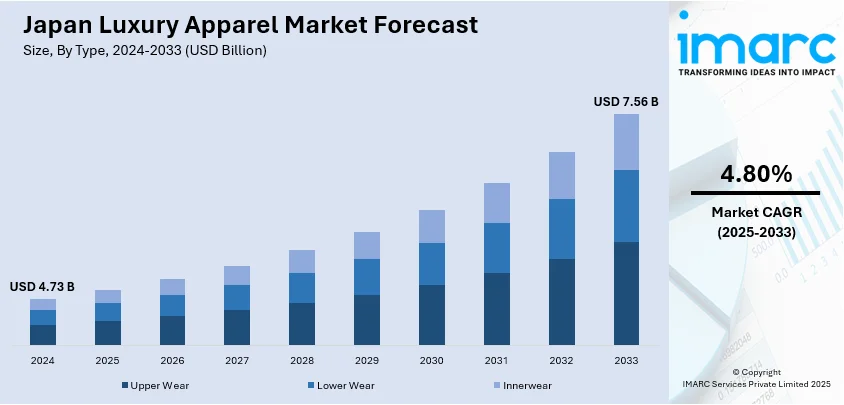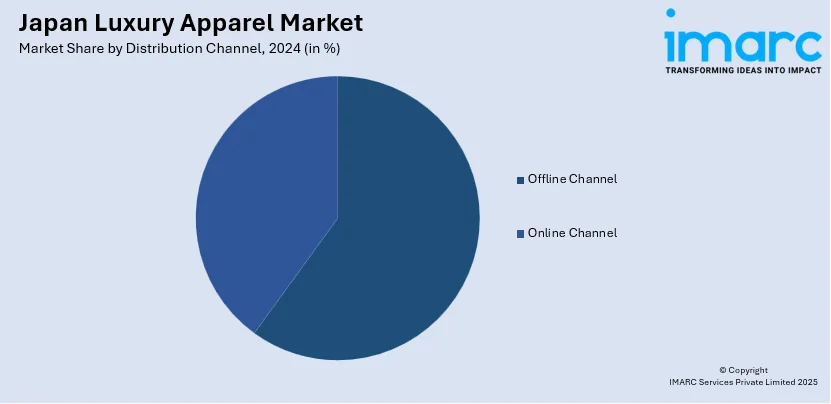
Japan Luxury Apparel Market Size, Share, Trends and Forecast by Type, Distribution Channel, End User, and Region, 2025-2033
Japan Luxury Apparel Market Overview:
The Japan luxury apparel market size reached USD 4.73 Billion in 2024. Looking forward, IMARC Group expects the market to reach USD 7.56 Billion by 2033, exhibiting a growth rate (CAGR) of 4.80% during 2025-2033. The market is experiencing steady growth, fueled by high consumer spending, strong fashion culture, and demand for premium and designer brands. Urbanization, digital retail expansion, and popularity of limited-edition collections are also some of the factors driving sales. Both global and local brands are focusing on innovation and sustainability to attract discerning buyers, while the Japan luxury apparel market share remains significant in this evolving competitive landscape.
|
Report Attribute
|
Key Statistics
|
|---|---|
|
Base Year
|
2024
|
|
Forecast Years
|
2025-2033
|
|
Historical Years
|
2019-2024
|
| Market Size in 2024 | USD 4.73 Billion |
| Market Forecast in 2033 | USD 7.56 Billion |
| Market Growth Rate 2025-2033 | 4.80% |
Japan Luxury Apparel Market Trends:
E-Commerce Growth
E-commerce and online platform growth are a key driver of the future direction of the Japan luxury fashion market. As consumers increasingly prefer convenience and digital interaction, luxury fashion brands are committing significant investment to online shopping channels, mobile apps, and virtual showrooms. Younger generations especially are demanding digital-first experiences, prioritizing ease of use, tailored recommendation, and real-time interaction with brands. Social networking sites and influencers also increase brand exposure, contributing to online sales. For instance, in January 2025, Perfect Moment Ltd. expanded its global market by partnering with prestigious sales agencies in Southern Europe and Japan to enhance brand presence. These partnerships aim to boost wholesale distribution as the brand prepares for the Winter Olympics, leveraging extensive regional expertise to reach luxury retailers and exclusive boutiques. Augmented reality fitting rooms, live fashion shows, and AI customer service aids are making shopping more seamless. Not only do these technologies increase reach but also foster customer loyalty. With a technologically advanced population and high internet penetration, Japan is poised to dominate digital luxury retail. This shift is a significant driver of Japan luxury apparel market growth, reflecting evolving consumer expectations in the digital age.

To get more information on this market, Request Sample
Expansion of Local Luxury Brands
The rise of domestic designers is reshaping the landscape of the Japan luxury apparel market. Traditionally dominated by international labels, the market is now witnessing a surge in homegrown brands that combine modern aesthetics with deep-rooted cultural craftsmanship. For instance, in February 2023, Japanese luxury fashion brand Snidel announced its plans to open its doors at MITSUKOSHI mall in BGC, as indicated by a new board-up. Known for its versatile street-meets-formal clothing, Snidel offers a range of apparel and accessories. These Japanese designers are gaining recognition for their attention to detail, quality fabrics, and innovative yet minimalist designs that resonate with local consumers. Additionally, the emphasis on authenticity, sustainability, and unique brand stories gives local labels a competitive edge. As consumers become more conscious and culturally connected, they increasingly prefer supporting national talent that reflects their identity and values. Collaborations between local designers and established fashion houses are also bridging gaps and enhancing visibility. This growing appreciation for domestic luxury has become a key factor contributing to market growth, reinforcing Japan’s role as a global fashion innovator.
Japan Luxury Apparel Market Segmentation:
IMARC Group provides an analysis of the key trends in each segment of the market, along with forecasts at the country and regional levels for 2025-2033. Our report has categorized the market based on type, distribution channel, and end user.
Type Insights:
- Upper Wear
- Lower Wear
- Innerwear
The report has provided a detailed breakup and analysis of the market based on the type. This includes upper wear, lower wear, and innerwear.
Distribution Channel Insights:

- Offline Channel
- Online Channel
A detailed breakup and analysis of the market based on the distribution channel have also been provided in the report. This includes offline channel and online channel.
End User Insights:
- Men
- Women
- Children
A detailed breakup and analysis of the market based on the end user have also been provided in the report. This includes men, women, and children.
Regional Insights:
- Kanto Region
- Kansai/Kinki Region
- Central/Chubu Region
- Kyushu-Okinawa Region
- Tohoku Region
- Chugoku Region
- Hokkaido Region
- Shikoku Region
The report has also provided a comprehensive analysis of all the major regional markets, which include Kanto Region, Kansai/Kinki Region, Central/Chubu Region, Kyushu-Okinawa Region, Tohoku Region, Chugoku Region, Hokkaido Region, and Shikoku Region.
Competitive Landscape:
The market research report has also provided a comprehensive analysis of the competitive landscape. Competitive analysis such as market structure, key player positioning, top winning strategies, competitive dashboard, and company evaluation quadrant has been covered in the report. Also, detailed profiles of all major companies have been provided.
Japan Luxury Apparel Market Report Coverage:
| Report Features | Details |
|---|---|
| Base Year of the Analysis | 2024 |
| Historical Period | 2019-2024 |
| Forecast Period | 2025-2033 |
| Units | Billion USD |
| Scope of the Report |
Exploration of Historical Trends and Market Outlook, Industry Catalysts and Challenges, Segment-Wise Historical and Future Market Assessment:
|
| Types Covered | Upper Wear, Lower Wear, Innerwear |
| Distribution Channels Covered | Offline Channel, Online Channel |
| End Users Covered | Men, Women, Children |
| Regions Covered | Kanto Region, Kansai/Kinki Region, Central/Chubu Region, Kyushu-Okinawa Region, Tohoku Region, Chugoku Region, Hokkaido Region, Shikoku Region |
| Customization Scope | 10% Free Customization |
| Post-Sale Analyst Support | 10-12 Weeks |
| Delivery Format | PDF and Excel through Email (We can also provide the editable version of the report in PPT/Word format on special request) |
Key Questions Answered in This Report:
- How has the Japan luxury apparel market performed so far and how will it perform in the coming years?
- What is the breakup of the Japan luxury apparel market on the basis of type?
- What is the breakup of the Japan luxury apparel market on the basis of distribution channel?
- What is the breakup of the Japan luxury apparel market on the basis of end user?
- What is the breakup of the Japan luxury apparel market on the basis of region?
- What are the various stages in the value chain of the Japan luxury apparel market?
- What are the key driving factors and challenges in the Japan luxury apparel market?
- What is the structure of the Japan luxury apparel market and who are the key players?
- What is the degree of competition in the Japan luxury apparel market?
Key Benefits for Stakeholders:
- IMARC’s industry report offers a comprehensive quantitative analysis of various market segments, historical and current market trends, market forecasts, and dynamics of the Japan luxury apparel market from 2019-2033.
- The research report provides the latest information on the market drivers, challenges, and opportunities in the Japan luxury apparel market.
- Porter's five forces analysis assist stakeholders in assessing the impact of new entrants, competitive rivalry, supplier power, buyer power, and the threat of substitution. It helps stakeholders to analyze the level of competition within the Japan luxury apparel industry and its attractiveness.
- Competitive landscape allows stakeholders to understand their competitive environment and provides an insight into the current positions of key players in the market.
Need more help?
- Speak to our experienced analysts for insights on the current market scenarios.
- Include additional segments and countries to customize the report as per your requirement.
- Gain an unparalleled competitive advantage in your domain by understanding how to utilize the report and positively impacting your operations and revenue.
- For further assistance, please connect with our analysts.
 Request Customization
Request Customization
 Speak to an Analyst
Speak to an Analyst
 Request Brochure
Request Brochure
 Inquire Before Buying
Inquire Before Buying




.webp)




.webp)












